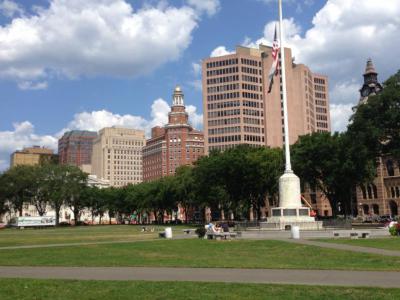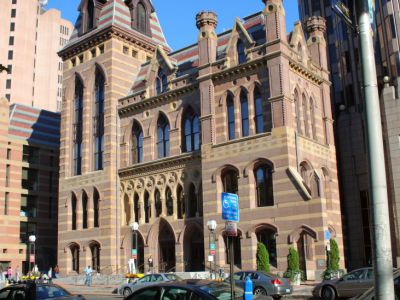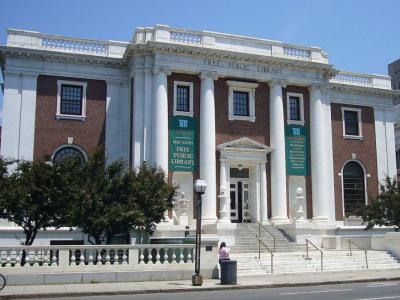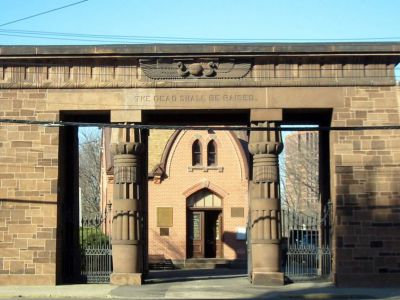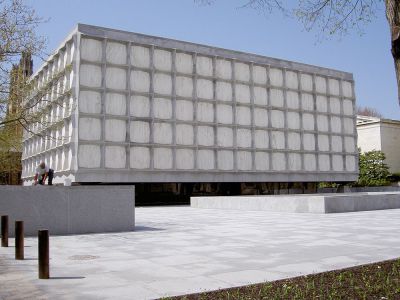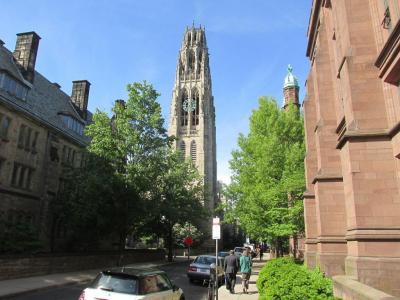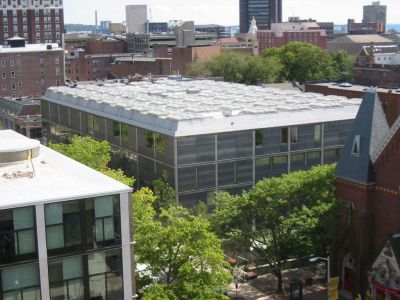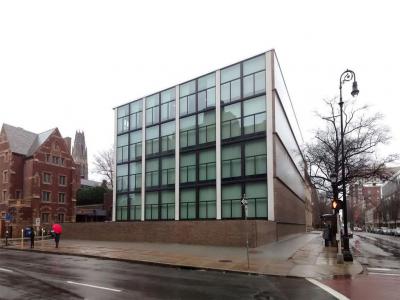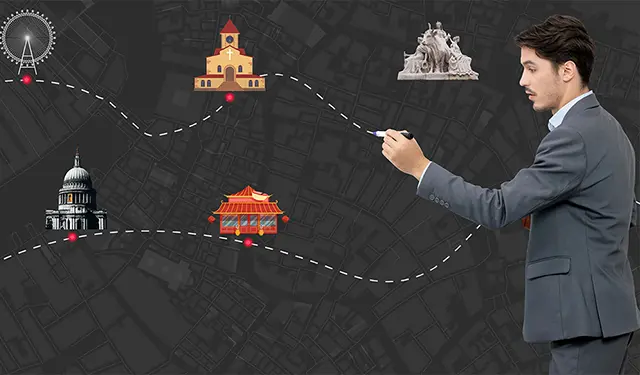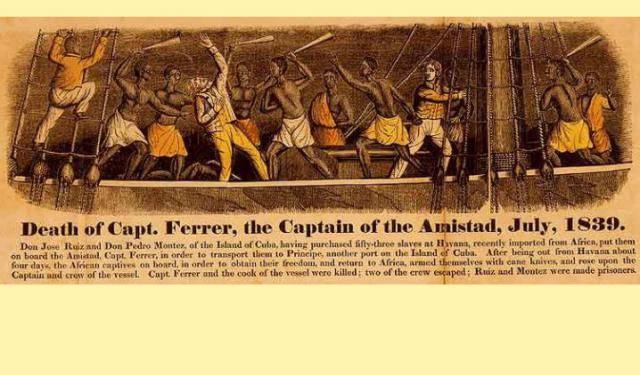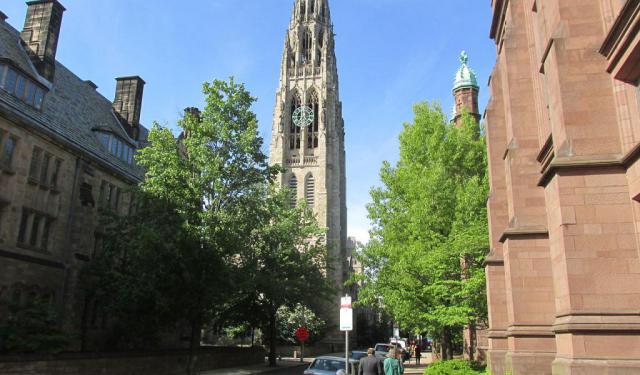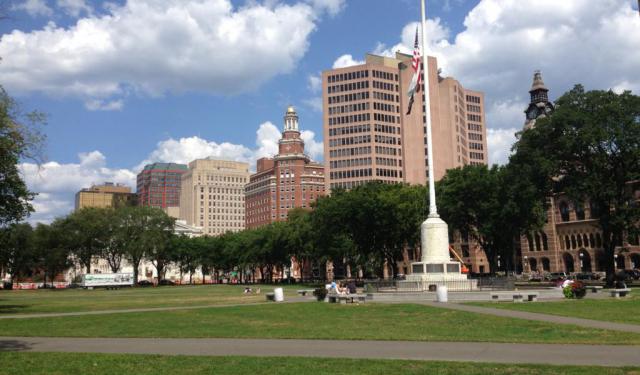
New Haven Introduction Walking Tour (Self Guided), New Haven
New Haven, Connecticut is widely known as the home to Yale University. However, the city isn't just a hip, university town. It is also full of history and sites that can't be found anywhere else.
The first planned city in the United States, New Haven boasts the easily maneuvered grid layout which makes it easy to navigate the city on foot. Situated at the center of this grid, New Haven Green park was an early marketplace for the Puritans who founded the city. Today, this spacious – 16-acre – space of greenery features art, monuments and regularly hosts various festivals.
Early on, New Haven was a co-capital of the state along with Hartford. It is no longer the administrative capital but does consider itself the "cultural capital" of the state. This is due to the booming art and music scene. Museums, like the Yale University Art Gallery and the Yale Center for British Art, are must see spots in the city.
Lovers of architecture are never disappointed when they visit New Haven. Gothic style architecture, like that found at the New Haven City Hall, meets Modern influences, like that of the Beinecke Rare Book and Manuscript Library. Walking from one building to the next is pleasant and easy with plenty to see and do along the way.
Take this self-guided walking tour to see the most interesting and historical sites in New Haven.
The first planned city in the United States, New Haven boasts the easily maneuvered grid layout which makes it easy to navigate the city on foot. Situated at the center of this grid, New Haven Green park was an early marketplace for the Puritans who founded the city. Today, this spacious – 16-acre – space of greenery features art, monuments and regularly hosts various festivals.
Early on, New Haven was a co-capital of the state along with Hartford. It is no longer the administrative capital but does consider itself the "cultural capital" of the state. This is due to the booming art and music scene. Museums, like the Yale University Art Gallery and the Yale Center for British Art, are must see spots in the city.
Lovers of architecture are never disappointed when they visit New Haven. Gothic style architecture, like that found at the New Haven City Hall, meets Modern influences, like that of the Beinecke Rare Book and Manuscript Library. Walking from one building to the next is pleasant and easy with plenty to see and do along the way.
Take this self-guided walking tour to see the most interesting and historical sites in New Haven.
How it works: Download the app "GPSmyCity: Walks in 1K+ Cities" from Apple App Store or Google Play Store to your mobile phone or tablet. The app turns your mobile device into a personal tour guide and its built-in GPS navigation functions guide you from one tour stop to next. The app works offline, so no data plan is needed when traveling abroad.
New Haven Introduction Walking Tour Map
Guide Name: New Haven Introduction Walking Tour
Guide Location: USA » New Haven (See other walking tours in New Haven)
Guide Type: Self-guided Walking Tour (Sightseeing)
# of Attractions: 10
Tour Duration: 2 Hour(s)
Travel Distance: 2.1 Km or 1.3 Miles
Author: AudreyB
Sight(s) Featured in This Guide:
Guide Location: USA » New Haven (See other walking tours in New Haven)
Guide Type: Self-guided Walking Tour (Sightseeing)
# of Attractions: 10
Tour Duration: 2 Hour(s)
Travel Distance: 2.1 Km or 1.3 Miles
Author: AudreyB
Sight(s) Featured in This Guide:
- New Haven Green
- New Haven City Hall
- New Haven Free Public Library
- Grove Street Cemetery
- Beinecke Rare Book and Manuscript Library
- Harkness Tower
- Yale Center for British Art
- Yale University Art Gallery
- Louis' Lunch (Oldest Hamburger Restaurant)
- Chapel Street
1) New Haven Green
New Haven Green is one of the oldest town greens in the United States. It was first established as a public marketplace in 1638. It later held a number of public buildings including a prison, a school and the First Methodist Church.
The 16-acre green is still home to three churches: the United Church on the Green, Center Church on the Green and Trinity Church on the Green. Each of these churches have unique architectural styles, which makes visiting them as part of a walking tour all the more interesting.
Structures along the perimeter of New Haven Green include a number of retail establishments and Yale University buildings and the Old Campus Courtyard. Likewise, visitors can see the New Haven Free Public Library, the New Haven Courthouse, the Richard C. Lee United States Courthouse and the Amistad Memorial.
New Haven Green is located in the center of the city. It is an excellent place to begin your walking tour.
The 16-acre green is still home to three churches: the United Church on the Green, Center Church on the Green and Trinity Church on the Green. Each of these churches have unique architectural styles, which makes visiting them as part of a walking tour all the more interesting.
Structures along the perimeter of New Haven Green include a number of retail establishments and Yale University buildings and the Old Campus Courtyard. Likewise, visitors can see the New Haven Free Public Library, the New Haven Courthouse, the Richard C. Lee United States Courthouse and the Amistad Memorial.
New Haven Green is located in the center of the city. It is an excellent place to begin your walking tour.
2) New Haven City Hall
The New Haven City Hall and County Courthouse is located on Church Street off of the New Haven Green. Though the pair of buildings are often spoken of together, it is the City Hall that is the older of the two by a full decade.
Architect Henry Austin designed the New Haven City hall in 1861. The High Victorian Gothic architectural style is evidenced by the clock tower, arched windows and turrets. The clock tower that adorns the city hall is not original but was rebuilt in 1975 after having been taken down.
Visitors are welcome to view the City Hall during regular office hours. They can explore the building's exterior at any time. Of particular note is the Amistad Memorial, which is directly in front of the City Hall. This memorial was erected in 1992 as the City Hall housed the prison that held the Africans who were involved in the Amistad Incident.
Architect Henry Austin designed the New Haven City hall in 1861. The High Victorian Gothic architectural style is evidenced by the clock tower, arched windows and turrets. The clock tower that adorns the city hall is not original but was rebuilt in 1975 after having been taken down.
Visitors are welcome to view the City Hall during regular office hours. They can explore the building's exterior at any time. Of particular note is the Amistad Memorial, which is directly in front of the City Hall. This memorial was erected in 1992 as the City Hall housed the prison that held the Africans who were involved in the Amistad Incident.
3) New Haven Free Public Library
Located on the New Haven Green, the New Haven Free Public Library is a stunning example of Colonial Revival Style architecture. It is also a beautiful example of the importance of literacy and appreciating art.
The building was erected in 1911 using a design by Cass Gilbert. The small building was expanded in 1990 to allow space for its ever-growing collection and art displays. Locals may refer to the library as the Ives Memorial Library in honor of Mary Ives who donated $300,000 to the city to erect the building.
Visitors to the library can view the Ives Gallery, which has a rotating exhibit of various works of art. They will also find two large murals in the main hall. Tourists are welcome in the New Haven Free Public Library during regular open hours. They can enjoy the art and architecture or take advantage of one of the library's many free programs that are open to the public.
The building was erected in 1911 using a design by Cass Gilbert. The small building was expanded in 1990 to allow space for its ever-growing collection and art displays. Locals may refer to the library as the Ives Memorial Library in honor of Mary Ives who donated $300,000 to the city to erect the building.
Visitors to the library can view the Ives Gallery, which has a rotating exhibit of various works of art. They will also find two large murals in the main hall. Tourists are welcome in the New Haven Free Public Library during regular open hours. They can enjoy the art and architecture or take advantage of one of the library's many free programs that are open to the public.
4) Grove Street Cemetery
Grove Street Cemetery is a historic cemetery located in the heart of New Haven, nestled within the Yale University campus. Established in 1796 and officially incorporated a year later, it was created to replace the overcrowded burial ground on the New Haven Green. It holds the distinction of being the first private, nonprofit cemetery in the world.
This cemetery marked a shift in burial practices, pioneering a thoughtfully planned layout with individually owned family plots, paved and named avenues, and ornamental plantings—features that helped redefine how society viewed death and burial. Historian Peter Dobkin Hall described it as a “real turning point” in the cultural treatment of death.
The cemetery owes its origins to a devastating yellow fever epidemic in 1794–95, which overwhelmed existing burial spaces. In response, Senator James Hillhouse and local families purchased land just north of Grove Street. The original 6-acre plot eventually expanded to 18 acres to accommodate demand. In 1821, monuments from the original New Haven Green burial site were transferred here.
One of Grove Street Cemetery’s most notable features is its Egyptian Revival gateway, completed in 1845. Designed by local architect Henry Austin and sculptor Hezekiah Augur—both of whom are buried there—the brownstone entrance bears the inscription “The Dead Shall Be Raised.” An 8-foot stone wall, added in the late 1840s, encloses the cemetery on three sides.
The site is the final resting place for many prominent figures, including 14 Yale University presidents, yet it was never an exclusive space and remained open to all. It reflects both the democratic and historical spirit of New Haven.
Grove Street Cemetery was added to the National Register of Historic Places in 1997 and designated a National Historic Landmark in 2000 for its historical and architectural significance. Today, it is maintained by Camco Cemetery Management and continues to be an important site of remembrance and heritage.
*** Amistad Freedom Trail ***
Among those interred here are the active members of the abolition movement, as well as those associated with African American history. A stone marker was dedicated by the Amistad Committee in September 2001 in remembrance of the six Mende African captives of La Amistad buried here.
This cemetery marked a shift in burial practices, pioneering a thoughtfully planned layout with individually owned family plots, paved and named avenues, and ornamental plantings—features that helped redefine how society viewed death and burial. Historian Peter Dobkin Hall described it as a “real turning point” in the cultural treatment of death.
The cemetery owes its origins to a devastating yellow fever epidemic in 1794–95, which overwhelmed existing burial spaces. In response, Senator James Hillhouse and local families purchased land just north of Grove Street. The original 6-acre plot eventually expanded to 18 acres to accommodate demand. In 1821, monuments from the original New Haven Green burial site were transferred here.
One of Grove Street Cemetery’s most notable features is its Egyptian Revival gateway, completed in 1845. Designed by local architect Henry Austin and sculptor Hezekiah Augur—both of whom are buried there—the brownstone entrance bears the inscription “The Dead Shall Be Raised.” An 8-foot stone wall, added in the late 1840s, encloses the cemetery on three sides.
The site is the final resting place for many prominent figures, including 14 Yale University presidents, yet it was never an exclusive space and remained open to all. It reflects both the democratic and historical spirit of New Haven.
Grove Street Cemetery was added to the National Register of Historic Places in 1997 and designated a National Historic Landmark in 2000 for its historical and architectural significance. Today, it is maintained by Camco Cemetery Management and continues to be an important site of remembrance and heritage.
*** Amistad Freedom Trail ***
Among those interred here are the active members of the abolition movement, as well as those associated with African American history. A stone marker was dedicated by the Amistad Committee in September 2001 in remembrance of the six Mende African captives of La Amistad buried here.
5) Beinecke Rare Book and Manuscript Library (must see)
The Beinecke Rare Book and Manuscript Library is located on the Yale University campus in the Hewitt Quadrangle. The library, which was established in 1963, is one of the world's largest institutions devoted entirely to rare books and manuscripts.
The building has a unique appearance that is indicative of its Modern style. Architect Gordon Bunshaft famously designed the building with thin, marble panels that filter indirect sunlight into the library in order to protect the rare manuscripts and books. The outstanding architecture is enhanced by the surrounding buildings, like the Lillian Goldman Law Library and Woolsey Hall, that have a more typically collegiate Beaux-Arts style.
Tourists may marvel at the design of the building, but if possible should plan to stop inside to see the golden light that spills in from the outside and the modernist sculptures by Isamu Naguchi. Though the bulk of the library is only available to Yale University faculty and students as well as visiting researchers, members of the public are typically permitted in exhibition hall, the ground floor and the mezzanine.
Beinecke holds one of the few copies of the original Gutenberg Bible. This is on display in the exhibition hall. John James Audubon's "Birds of America" is also permanently on display. Visitors can find the 1742 Library of Yale College on the ground floor. They will also see some of the earliest books published in the West with dates that go back to 1472.
Special exhibitions are offered throughout the year as well. Previous exhibitions have included modern photography, a focus on poetry and the display of the Declaration of Independence.
Why You Should Visit:
- To see an original Gutenberg Bible
- To marvel at Modern architecture
Tips:
Anyone wanting to see more than the exhibition hall will have to contact Beinecke in advance. Only approved researchers can enter the reading room, which is open by appointment only.
The building has a unique appearance that is indicative of its Modern style. Architect Gordon Bunshaft famously designed the building with thin, marble panels that filter indirect sunlight into the library in order to protect the rare manuscripts and books. The outstanding architecture is enhanced by the surrounding buildings, like the Lillian Goldman Law Library and Woolsey Hall, that have a more typically collegiate Beaux-Arts style.
Tourists may marvel at the design of the building, but if possible should plan to stop inside to see the golden light that spills in from the outside and the modernist sculptures by Isamu Naguchi. Though the bulk of the library is only available to Yale University faculty and students as well as visiting researchers, members of the public are typically permitted in exhibition hall, the ground floor and the mezzanine.
Beinecke holds one of the few copies of the original Gutenberg Bible. This is on display in the exhibition hall. John James Audubon's "Birds of America" is also permanently on display. Visitors can find the 1742 Library of Yale College on the ground floor. They will also see some of the earliest books published in the West with dates that go back to 1472.
Special exhibitions are offered throughout the year as well. Previous exhibitions have included modern photography, a focus on poetry and the display of the Declaration of Independence.
Why You Should Visit:
- To see an original Gutenberg Bible
- To marvel at Modern architecture
Tips:
Anyone wanting to see more than the exhibition hall will have to contact Beinecke in advance. Only approved researchers can enter the reading room, which is open by appointment only.
6) Harkness Tower (must see)
Harkness Tower is a prominent masonry structure located at Yale University in New Haven. Completed in 1922 as part of the Collegiate Gothic Memorial Quadrangle, the tower stands as a tribute to Charles William Harkness, a Yale graduate from the Class of 1883 and the brother of Edward S. Harkness, one of Yale’s most generous benefactors. It was donated by their mother, Anna M. Harkness, in memory of Charles.
Designed by architect James Gamble Rogers, a Yale College classmate of Edward Harkness, the tower was built between 1917 and 1921. It marked the first modern construction of a couronne ("crown") tower in the English Perpendicular Gothic style. Rogers drew inspiration from England’s 15th-century Boston Stump and the tower of Saint Giles' Church in Wrexham, Wales—the latter notably housing the tomb of Elihu Yale, the university's namesake.
Standing at 216 feet (66 meters), the tower was intentionally built with one foot every year since Yale’s founding at the time of construction. Its design includes a square base rising through multiple stages to an octagonal crown adorned with stone finials. It contains 284 steps from the ground to the rooftop.
Harkness Tower became part of Branford College when Yale’s residential college system launched in 1933. A major renovation took place between 2009 and 2010 to restore the tower’s masonry and architectural details.
Midway up Harkness Tower, four copper clockfaces mark the time, with the Yale Memorial Carillon bells ringing behind them. Below, the tower houses the carillon console, practice instruments, office space for the Yale Guild of Carillonneurs, a disused water tank, a historic chimes console, and a memorial chapel. Now an iconic Yale symbol, the tower even features on The Yale Herald masthead and inspired the Cathedral of Christ the King in Hamilton, Ontario.
Designed by architect James Gamble Rogers, a Yale College classmate of Edward Harkness, the tower was built between 1917 and 1921. It marked the first modern construction of a couronne ("crown") tower in the English Perpendicular Gothic style. Rogers drew inspiration from England’s 15th-century Boston Stump and the tower of Saint Giles' Church in Wrexham, Wales—the latter notably housing the tomb of Elihu Yale, the university's namesake.
Standing at 216 feet (66 meters), the tower was intentionally built with one foot every year since Yale’s founding at the time of construction. Its design includes a square base rising through multiple stages to an octagonal crown adorned with stone finials. It contains 284 steps from the ground to the rooftop.
Harkness Tower became part of Branford College when Yale’s residential college system launched in 1933. A major renovation took place between 2009 and 2010 to restore the tower’s masonry and architectural details.
Midway up Harkness Tower, four copper clockfaces mark the time, with the Yale Memorial Carillon bells ringing behind them. Below, the tower houses the carillon console, practice instruments, office space for the Yale Guild of Carillonneurs, a disused water tank, a historic chimes console, and a memorial chapel. Now an iconic Yale symbol, the tower even features on The Yale Herald masthead and inspired the Cathedral of Christ the King in Hamilton, Ontario.
7) Yale Center for British Art (must see)
A must see stop on any walking tour of New Haven is the Yale center for British Art. This museum has the largest collection of British art outside of the United Kingdom. Visitors can find paintings, sculptures, drawings and rare books and manuscripts on permanent display.
Philanthropist Paul Mellon gifted his collection of British art and an endowment to Yale University in 1966. This was the basis for the Yale Center for the art museum. The university chose to have the new building constructed close to the Yale University Art Gallery on Chapel Street near the Yale School of Art.
Architect Louis Kahn designed the building in a Modern architectural style utilizing glass and steel. The building is encased in glass, including skylights, because the architect wanted to allow in as much natural light as possible. The interior is a combination of natural materials like marble, oak and linen.
There are currently about 2,000 works on display. Some artists featured in the Yale Center for British Art include Thomas Gainsborough, George Stubbs, Joseph Wright, John Constable, William Blake and John Wootton. The museum also features works from non-British artists who spent significant time in the United Kingdom. Some of these artists include Peter Paul Rubens, Anthony van Dyck and James McNeill Whistler.
The museum typically offers free, docent-led tours to the public that cover both the art within the building and the architecture of the building itself. Visitors are also welcome to take part in special programming that is offered on a rotating basis throughout the year.
Why You Should Visit:
- To see the largest collection of British art outside of Great Britain
- To pick up a souvenir at the museum shop
Tips:
The Yale Center for British Art recommends that those who plan to visit this museum and the Yale University Art Gallery on the same day call both places in advance to ensure that docents are available for tours.
Philanthropist Paul Mellon gifted his collection of British art and an endowment to Yale University in 1966. This was the basis for the Yale Center for the art museum. The university chose to have the new building constructed close to the Yale University Art Gallery on Chapel Street near the Yale School of Art.
Architect Louis Kahn designed the building in a Modern architectural style utilizing glass and steel. The building is encased in glass, including skylights, because the architect wanted to allow in as much natural light as possible. The interior is a combination of natural materials like marble, oak and linen.
There are currently about 2,000 works on display. Some artists featured in the Yale Center for British Art include Thomas Gainsborough, George Stubbs, Joseph Wright, John Constable, William Blake and John Wootton. The museum also features works from non-British artists who spent significant time in the United Kingdom. Some of these artists include Peter Paul Rubens, Anthony van Dyck and James McNeill Whistler.
The museum typically offers free, docent-led tours to the public that cover both the art within the building and the architecture of the building itself. Visitors are also welcome to take part in special programming that is offered on a rotating basis throughout the year.
Why You Should Visit:
- To see the largest collection of British art outside of Great Britain
- To pick up a souvenir at the museum shop
Tips:
The Yale Center for British Art recommends that those who plan to visit this museum and the Yale University Art Gallery on the same day call both places in advance to ensure that docents are available for tours.
8) Yale University Art Gallery (must see)
The Yale University Art Gallery is located near the Old Campus Courtyard and less than two blocks from New Haven Green. It is an excellent place to spend a couple of hours or an entire afternoon. Every visitor to New Haven should stop by the Yale University Art Gallery for multiple reasons.
This gallery is the oldest art museum in the western hemisphere. It was established in 1832 after artist John Trumbull donated over 100 paintings to the university. His donated paintings include "Battle of Bunker Hill," "Declaration of Independence" and "Surrender of Lord Cornwallis," among others.
Trumbull also designed the original picture gallery, which was razed and replaced with a Tuscan Romanesque style building designed by Egerton Swartwout in 1928. It is now known as the Olde Yale Art Gallery Building.
The current main hall of the Yale University Art Gallery was designed by Louis Kahn in 1947. The Modern architectural style uses geometric shapes, including a tetrahedral ceiling and cylindrical staircase. This was the first Modernist building on the Yale University campus.
The gallery holds works from famed artists like Peter Paul Rubens, Paul Gauguin and Vincent Van Gogh. However, visitors won't just see European art. They will also be greeted with art from the Americas, Africa and Asia. The gallery has permanent exhibits of ancient art, sculpture, modern art and photography.
Traveling exhibits are often featured at the Yale University Art Gallery. Past exhibits have included a study on caricatures, ceremonial dress, global baroque and the art of light.
Why You Should Visit:
- To see the oldest art gallery in the western hemisphere
- To bask in art from throughout the ages
Tips:
Visitors are welcome to explore the gallery on their own. However, those seeking a docent-led tour should call in advance or check the website to ensure tours are available.
This gallery is the oldest art museum in the western hemisphere. It was established in 1832 after artist John Trumbull donated over 100 paintings to the university. His donated paintings include "Battle of Bunker Hill," "Declaration of Independence" and "Surrender of Lord Cornwallis," among others.
Trumbull also designed the original picture gallery, which was razed and replaced with a Tuscan Romanesque style building designed by Egerton Swartwout in 1928. It is now known as the Olde Yale Art Gallery Building.
The current main hall of the Yale University Art Gallery was designed by Louis Kahn in 1947. The Modern architectural style uses geometric shapes, including a tetrahedral ceiling and cylindrical staircase. This was the first Modernist building on the Yale University campus.
The gallery holds works from famed artists like Peter Paul Rubens, Paul Gauguin and Vincent Van Gogh. However, visitors won't just see European art. They will also be greeted with art from the Americas, Africa and Asia. The gallery has permanent exhibits of ancient art, sculpture, modern art and photography.
Traveling exhibits are often featured at the Yale University Art Gallery. Past exhibits have included a study on caricatures, ceremonial dress, global baroque and the art of light.
Why You Should Visit:
- To see the oldest art gallery in the western hemisphere
- To bask in art from throughout the ages
Tips:
Visitors are welcome to explore the gallery on their own. However, those seeking a docent-led tour should call in advance or check the website to ensure tours are available.
9) Louis' Lunch (Oldest Hamburger Restaurant)
Louis' Lunch is not just any restaurant. It is the oldest hamburger restaurant in the United states. Established in 1892, Louis' Lunch claims to be the originator of the hamburger when a patron asked for a quick lunch that could be eaten by hand.
Though others also claim the invention of the hamburger, the Library of Congress recognizes Louis' Lunch as the originator.Louis' Lunch also claims to be one of the oldest family-run companies in the United States. It is currently owned and operated by the fourth generation of the Lassen family.
Tourists can enjoy a hamburger at Louis' Lunch Tuesdays through Saturdays. The menu also includes drinks, sides and homemade pie. Remember to bring some money as Louis' Lunch is a cash-only establishment.
Louis' Lunch is located on Crown Street near New Haven Green. It is within easy walking distance of the Yale University Art Gallery and the Yale Center for British Art.
Though others also claim the invention of the hamburger, the Library of Congress recognizes Louis' Lunch as the originator.Louis' Lunch also claims to be one of the oldest family-run companies in the United States. It is currently owned and operated by the fourth generation of the Lassen family.
Tourists can enjoy a hamburger at Louis' Lunch Tuesdays through Saturdays. The menu also includes drinks, sides and homemade pie. Remember to bring some money as Louis' Lunch is a cash-only establishment.
Louis' Lunch is located on Crown Street near New Haven Green. It is within easy walking distance of the Yale University Art Gallery and the Yale Center for British Art.
10) Chapel Street
The Chapel Street historic district is 23 acres of history in the center of downtown New Haven. It is bordered by the Dwight Street historic district to the west and Yale University to the north.
The historic district includes buildings that date as far back as 1817. Some of these historic buildings include Warner Hall, built in 1892; Townsend Block, constructed in 1832; Trinity Church, built in 1868 and 1911's Taft Hotel.
Chapel Street is dotted with dining establishments, boutiques and unique spots to stop and enjoy. Walk through a park, find a new favorite musician at a music venues or even get a tattoo. Nearly every university town convenience and anomaly can be found on Chapel Street.
Chapel Street is a good place for a leisurely stroll in New Haven. Visitors can walk along Chapel Street to reach their next destination while also enjoying the historic district itself.
The historic district includes buildings that date as far back as 1817. Some of these historic buildings include Warner Hall, built in 1892; Townsend Block, constructed in 1832; Trinity Church, built in 1868 and 1911's Taft Hotel.
Chapel Street is dotted with dining establishments, boutiques and unique spots to stop and enjoy. Walk through a park, find a new favorite musician at a music venues or even get a tattoo. Nearly every university town convenience and anomaly can be found on Chapel Street.
Chapel Street is a good place for a leisurely stroll in New Haven. Visitors can walk along Chapel Street to reach their next destination while also enjoying the historic district itself.
Walking Tours in New Haven, Connecticut
Create Your Own Walk in New Haven
Creating your own self-guided walk in New Haven is easy and fun. Choose the city attractions that you want to see and a walk route map will be created just for you. You can even set your hotel as the start point of the walk.
New Haven's Historical Buildings Tour
The first ever planned city in the United States, New Haven, Connecticut, is famous for a wealth of prominent homes that have stood the test of time.
Some of these buildings, like the Caroline Nicoll House, showcase the elegant symmetry and refined detailing befitting Federal style. Others, like the John Cook House, represent a prime example of the Greek Revival architecture, characterized by... view more
Tour Duration: 2 Hour(s)
Travel Distance: 2.9 Km or 1.8 Miles
Some of these buildings, like the Caroline Nicoll House, showcase the elegant symmetry and refined detailing befitting Federal style. Others, like the John Cook House, represent a prime example of the Greek Revival architecture, characterized by... view more
Tour Duration: 2 Hour(s)
Travel Distance: 2.9 Km or 1.8 Miles
Amistad Freedom Trail
The Cuban schooner La Amistad made history in July 1839 when a group of African captives on board unshackled themselves during the voyage, took control of the ship, and eventually landed on the US shore. The slaves responsible for the revolt were interned in New Haven, Connecticut to be tried for mutiny and murder. The case known as The United States vs The Amistad (1841) gained international... view more
Tour Duration: 1 Hour(s)
Travel Distance: 1.8 Km or 1.1 Miles
Tour Duration: 1 Hour(s)
Travel Distance: 1.8 Km or 1.1 Miles
Yale University Walking Tour
Perhaps the main attraction that puts the picturesque town of New Haven, Connecticut, on the international tourist map is Yale University. Founded in 1701, this esteemed educational institution ranks among the oldest and most prestigious in the United States.
In addition to its academic excellence, and because of its age, Yale boasts a great deal of architectural beauty. A diverse range of... view more
Tour Duration: 1 Hour(s)
Travel Distance: 1.4 Km or 0.9 Miles
In addition to its academic excellence, and because of its age, Yale boasts a great deal of architectural beauty. A diverse range of... view more
Tour Duration: 1 Hour(s)
Travel Distance: 1.4 Km or 0.9 Miles
The Most Popular Cities
/ view all
